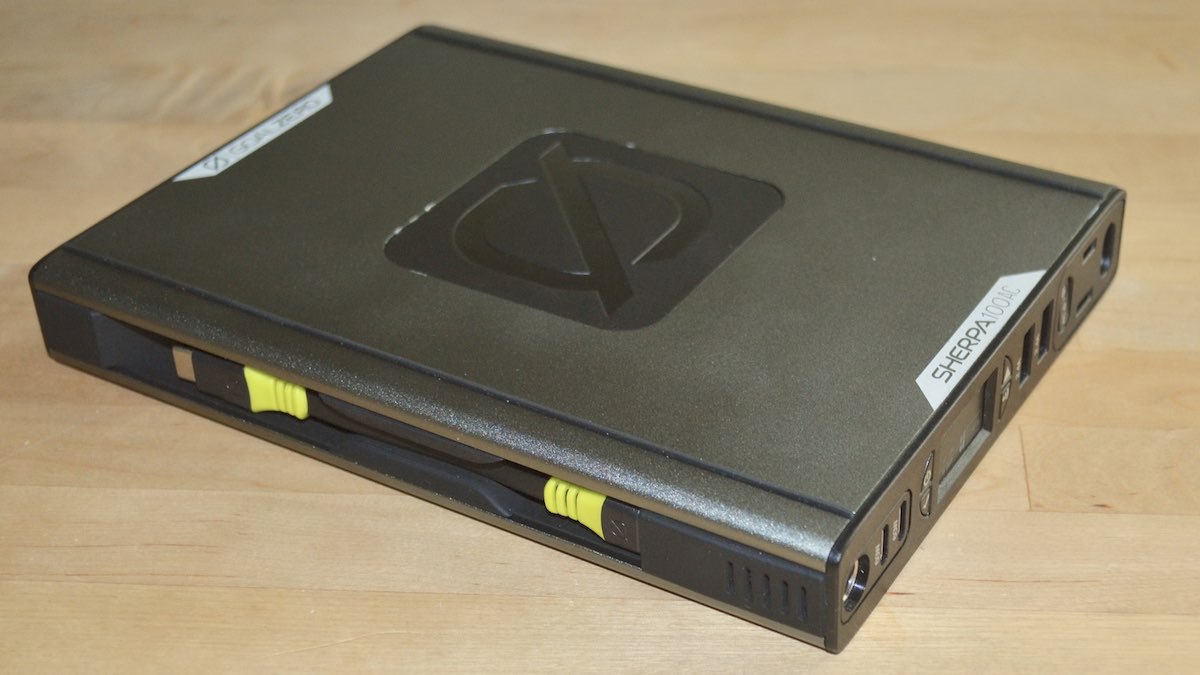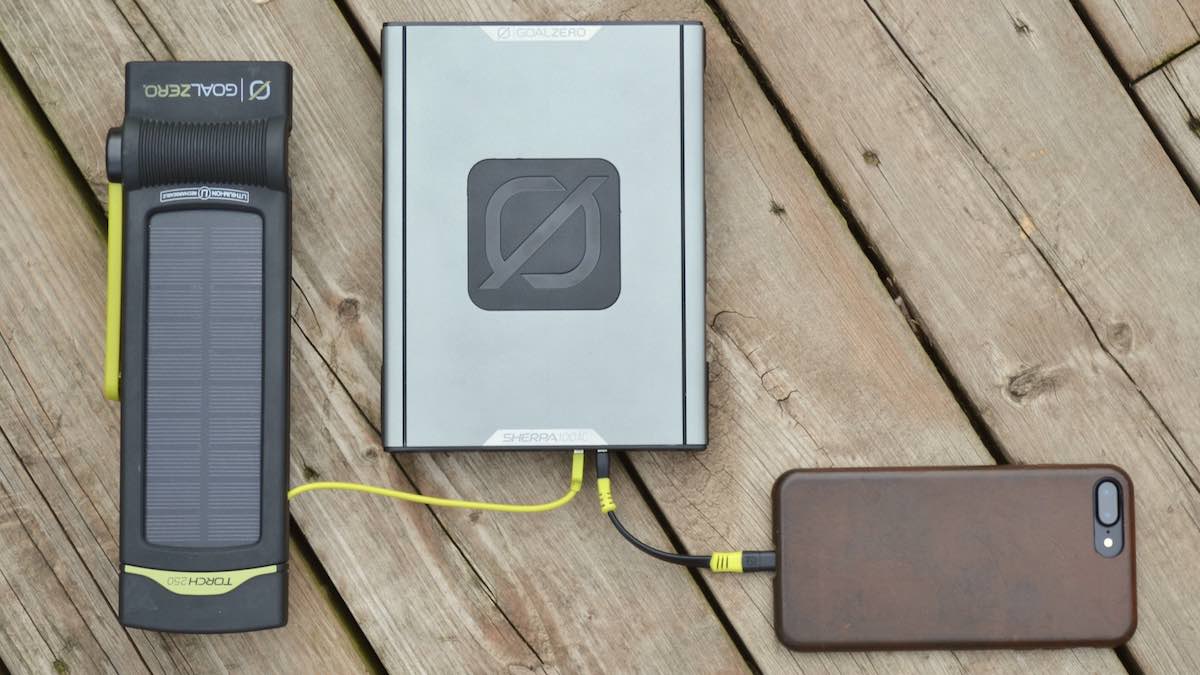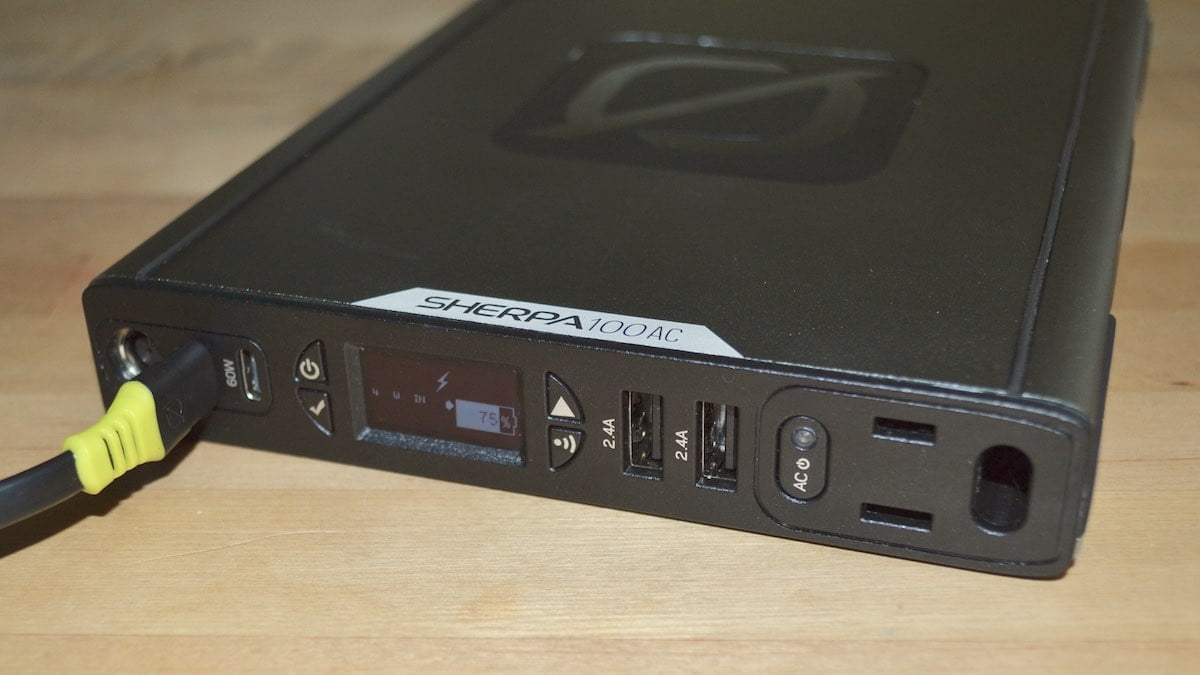
Last summer, I reviewed Goal Zero’s Yeti 1400. That was a 45-pound portable power station with a battery capable of running a full-sized refrigerator for over 12 hours. This time around I tested another new Goal Zero product, but this one was considerably more portable (and more affordable): the Sherpa 100AC Portable Power Bank.
Maximum Power, Portable Form Factor

The Sherpa 100AC was designed to be the kind of portable power bank that those who travel with a lot of gear can rely on.
At the heart of the system is a 94.7Wh Li-Ion NMC battery (25600mAh). That means it sneaks in under the maximum capacity for lithium-ion batteries on airplanes, as set out in FAA regulations. It weighs just 2.0 pounds. So what kind of charge capability are we talking? According to Goal Zero, the Sherpa 100AC can charge:
• Smartphones up to 10 times
• Tablets up to three full charges
• Laptops up to two charges
• Cameras up to 18 charges
Another traveler-friendly feature is the inclusion of popular charge cables (Lightning, Micro USB, USB-C, and USB-C to USB-C). Two of these can slot securely into the side of the Sherpa 100AC, so you won’t forget to pack them. There’s also a zipped travel case available as an optional extra.
Flexibility
Sheer capacity and a portable form factor are great, but the Goal Zero Sherpa 100AC also stands out for its flexibility.
The top of the case is a 2.4A Qi wireless charge pad. There are two 60W USB-C ports and a pair of 2.4A standard USB ports. There’s also a 100W AC outlet for devices with specialized chargers, like laptops (it’s not meant to run motorized equipment).
To recharge the Sherpa 100AC itself, you connect to those USB-C ports (they’re two-way). You can use your own USB charger, a 12V car adapter, the optional power supply (which will do the job in about three hours), or go off the grid and plug in an optional Goal Zero Nomad 28 Plus solar panel (which should fully charge the power bank in 7-14 hours).
OLED Display
The front of the Sherpa 100AC has a handy, built-in OLED display. You can cycle through information including battery percentage left, time to recharge, and detailed port info. It’s not huge, but it’s very crisp.
Hands-On With the Sherpa 100AC
It was during the initial charging of the power bank that I ran into my primary complaint about the Sherpa 100AC. There’s no power adapter in the box, instead, it’s $34.95 extra. Goal Zero says that adapter will recharge the power bank in three hours, but the 2.4A USB charger I had handy took nearly all day.

In terms of charging mobile devices, the Sherpa 100AC could handle pretty much anything I threw at it. There was no problem charging three devices at a time, and if I brought this thing on a trip with me, it could keep my iPhone going for the better part of two weeks. I powered a 13-inch MacBook Air (using that AC outlet) for eight hours.
Then I flew too high… I plugged in a gaming laptop I had here for testing—one that’s rated to draw 135W. Its battery was dead, but plugged into the Sherpa 100AC it powered up, began charging and ran for 30 minutes. This caused the power bank’s cooling fan to blow loudly, but it held its own until I started up Fortnite with the graphics cranked up. After a minute or so of this, the Sherpa shut down and the OLED display showed a message saying maximum power had been exceeded and a restart would be required.

Still, pretty impressive. And good to know the fail-safes are there. After that restart, all was fine.
The Goal Zero Sherpa 100AC isn’t cheap. It’s $299.95, and if you want the extras, they can add up: $34.95 for the power adapter, $9.95 for the zippered carrying case, and that Nomad 28 Plus solar panel is $249.95 more.
However, if you travel at all and bring a collection of gadgets with you, the Goal Zero Sherpa 100AC is a great accessory. It’s very travel-friendly, very flexible, well designed, and eliminates worries about running out of power, even in the air.




Hey Brad,
This is entirely off topic but I didn’t know how else to reach you. Today I stumbled on a 2013 posting of yours where you described your solution to freeing a DVD that was stuck in your iMac (tape on a putty knife).
A few weeks ago my husband accidentally shoved a micro SD card into my DVD drive. I have been lamenting ever since and had no idea what to do. I decided today to poke through the internet and found your old post. I followed your instructions and WOW! it worked beautifully. You are brilliant! Thank you.
Vera from Ottawa
Ha! Thanks so much for the comment —glad it worked for you. Cheers, Brad.
Sherpa 100AC review:
The Goal Zero Sherpa 110AC is under-promised and over-delivered.
The Goal Zero Sherpa 110AC is under-promised and over-delivered.
I charged my Sherpa 100AC to 100% from 110v power adapter when I first received it. Then I put it to its first and stringent test: charging a DJI Phantom 4 Pro battery from the Sherpa 100AC’s 110V AC-port. Mind you that the Sherpa 100AC is rated “up to 100 Watts” (.9 Amps). The Sherpa 100AC charged the DJI Phantom 4 Pro battery from depleted to 100% without a hiccup. At times, the Sherpa’s informative and always visible illuminated display showed the drone battery drawing as much as 122 Watts.
Now, admittedly an OCD person when it comes to “backups” of every type, I have many different “power banks” and solar panels…Although mostly Goal Zero. My place looks like a Goal Zero showroom. I tested the DJI Phantom 4 Pro drone battery against two other types of, supposedly higher capacity, power banks: The “Suaoki S270 Portable Power Station 150Wh Quiet Gas Free Camping Generator QC3.0 UPS Lithium Power Supply”, rated at 150Wh and “max 100W, peak power 150W”. After a few minutes of charging the DJI drone battery, the Suaoki Shut down completely. I restarted the S270 and again, after a few minutes, it shut down completely. While the S270 has several 12V, USB and 2 110V AC outlets, it does not have a Qi 5W wireless charger like the Sherpa 110AC does, not is it as compact as the Sherpa 110AC or have an informative display like the Sherpa 110AC does.
Next, I tested it against a iPrigent “Portable Solar Generator Power Source – 41600mAh 154Wh” which claims to have a 120 Watt inverter output. When I attempted to charger the DJI Phantom 4 Pro battery, it shut down in less than a minute. The iPrigent has a single 110 v output port/receptacle and two USB ports. The input port is a DC 19 volt, 2 Amp socket that charges the unit from an AC-adapter or solar panel. It lacks any “informative display” and simply states it remaining capacity with a series of 4 tiny blue LEDs.
Now back to the Goal Zero Sherpa 100AC: It is compact and high quality throughout.
For input (recharging it) it has a standard 8mm Goal Zero input receptacle and two Type C connectors, each rated at 60 Watts each. The Type C connector is 2 way so it can be used for input (recharging) and output (charging something else). It can be recharged with a 12v car adapter as well. The Sherpa 100AC has 2 USB ports rated at 2.4 Ams each, and 1 110 volt AC receptacle . It has a wireless Qi 5 Watt charging pad for phones that have Qi compatible wireless charging, as with the latest iPhones and many Android devices and tablets.
I used the Sherpa 100AC to wireless-charge my nearly dead iPhone X, which took between 2 and 3 hours and only consumed 22% of the Sherpa 100AC’s capacity.
I’m a photographer, using drones, Matterport Systems and conventional still and video equipment. I almost “live” on battery and solar power. The Sherpa 100AC is now my favorite all-around device when I need its capacity. For higher capacity demands I rely on the Goal Zero Yeti 400 Lithium and Yeti 1400 Lithium. In my opinion, the Goal Zero Nomad 28 Plus is the most convenient way to charge the Sherpa 100AC when sun is available.
When you want remote or backup power, “usually reliable” is not an option. As a matter of fact, I consider “usually reliable” an oxymoron. I have found this Sherpa 100AC to be “reliable” as in “completely reliable”, which is what you want. If you’re considering a Power Bank of this capacity, look no further and get the Goal Zero Sherpa 100AC. I doubt that you’d have any second-thoughts!
I was not compensated for this review nor was it solicited by them. I purchased the product from their web site. #Solar #PowerBank #GoalZero #Sherrpa Brookfield Photographer
#Sherpa100AC #powerStation #BatteryPack #ChargeADrone
Hello…just received my new Sherpa 100AC
charging it to 100%….then going to plug in 110Volt wall lamp / 60 watt Led bulb
should be able to handle it ?